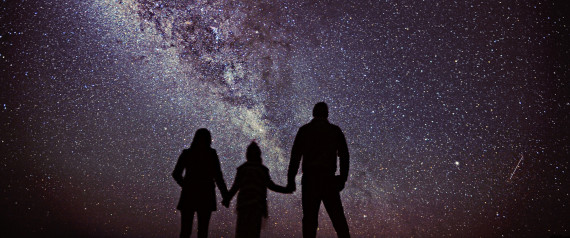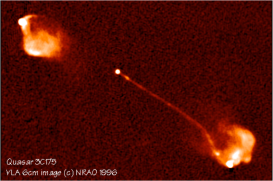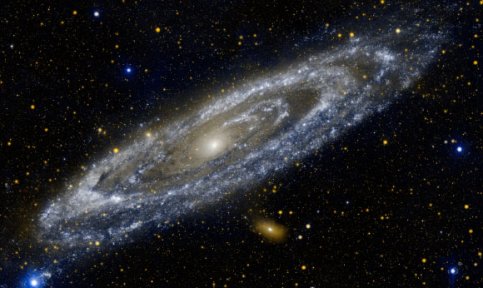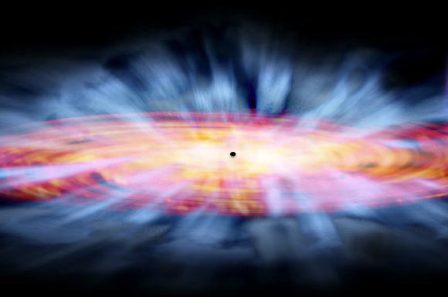It was 2003, and a dark and stormy night. I was in my room on the phone with my best friend being a typical high schooler, avoiding my grandparents, and watching a science special on PBS. The show was “Horizon: Supermassive Black Holes.” The reason I remember that night is because we were gasping at the scientific revelations together like complete in-tune nerds. Now on Netflix, I watched it again the other day and got excited all over again about black holes, so I’m going to tell you about them. The super massive ones. Cue dramatic music.
First of all, what is a black hole?
A black hole is an object so dense, with gravity so strong, that even light doesn’t move fast enough to escape. In other words, the “escape velocity” from a black hole is faster than the speed of light.
If we can’t see black holes, how do we know anything about them? Much of what is known about black holes is based on what is observed around these super massive dark objects, such as how fast local stars are orbiting. There are only theories about what lies at the center of a black hole. Physicists call it a singularity, and the laws of physics there don’t quite add up. Will you find a tunnel to another universe? Some crazy ball of multidimensional universe string? You would probably find crushing forces, in any case.
Two kinds of black holes have been identified so far – stellar black holes and supermassive black holes. Stellar black holes are just your run-of-the-mill black holes that get featured in Star trek and movies like Interstellar. They are the result of stars that lived out their lives, then exploded and collapsed. They are usually described as having the mass of a couple of suns (solar masses). Supermassive black holes are millions of times bigger. We’re not really talking about “size” here, though, in the way you might think of it. Because we can’t see its size. All comparisons are based on its mass, which can be calculated by the way it affects the movement of surrounding matter.
Where do they come from?
The first cool thing about supermassive black holes is that scientists still aren’t sure where they came from or how they formed. However, the commonly accepted theory among astronomers goes like this: in the early universe, after matter started to form into dust and gas and the universe began to cool, the matter coalesced into the first stars. These stars were much larger and burned hotter than the stars today. Consequently these giant stars burned out relatively quickly and then exploded, like stars do at the end of their life, and the matter that they expelled became other stars. The leftover star material collapsed into a giant black hole that fed on the surrounding matter.
Where are they found?
This was the interesting question of the Netflix special.
It all started with research into quasars. Quasars are one of the brightest objects in the universe. Originally quite mysterious, eventually astronomers determined that these amazingly luminous objects were actually located in the center of very distant galaxies. What’s more, the incredible amount of light and radiation emitted from a quasar is the result of a feeding supermassive black hole.
The matter falling into the hole – like liquid down a drain – reaches speeds nears the speed of light. Because this matter moves so fast, it becomes superheated and gives off intense energy, effectively pushing away some of the matter just out of reach of the black hole’s grasp. These super energized particles shoot off in high-energy jets with a brightness that outshines all of the surrounding stars.
Since “active” supermassive black holes were found to be sitting at the center of these galaxies with light-emitting quasars, scientists decided to compare these distant active galaxies with quiet, inactive galaxies to get an idea of how massive the black hole was at the center. Quiet galaxies like our own Milky Way have dark centers that astronomers assumed contained nothing of interest, which means the rotation of the stars at the center would have a predictable speed and pattern.
What the scientists found, however – and cue dramatic music – was that these quiet galaxies do not, actually, have a quiet center. There was something there. Something so massive that the stars were circling the center at incredible speeds, and yet it was invisible.
It could only mean one thing: there were supermassive black holes at the center of these quiet galaxies. In the heart of our own galaxy, in a region called Sagittarius A*, is giant destructive force. The more galaxies they looked at, the more evidence they found that almost ALL galaxies have supermassive black holes at their core.
Where do they fit into the universe?
An interesting question arose with the finding that super massive black holes reside in the center of galaxies: Why?
The most fun question to ask in science is the why. It’s also usually the most complicated question to answer. Why are there supermassive black holes at the center of galaxies? One really interesting theory is that the black holes were there first, and gave rise to the galaxy. The data to support this theory is based on the speed of the stars moving around the outer edge of the galaxy. These stars are too far away to be affected by the central black hole. However, when measured, astronomers found the velocity of stars in the rotating galaxies to be equivalent to the velocity if the black hole was indeed influencing them. This means that at some point in the past, those stars were close enough to be affected by the mass of the black hole.
This finding supported the theory that supermassive black holes play an important role in the evolution of galaxies. As I described so far, it’s thought that supermassive black holes formed in the early universe. When supermassive black holes consume matter, it swirls around so fast that it actually flings some of the outer material away, out of reach. Thus, the theory goes that these feeding black hole giants were consuming gas and matter, growing larger, while flinging high energy particles and radiation away from themselves that would become orbiting stars. The supermassive black holes do not continuously feed, though, as sometime the surrounding matter gets pushed far enough away to be out of range, and the black hole will go quiet for a time. Someone described this nicely as it being as if the black hole was “burping.”
The evolution of galaxies also involves explosions and collisions and a lot of other destructive cosmic events. But just think about the idea that black holes could play a creative role. These destructive monsters actually gave birth to galaxies, and within one of those galaxies the earth was born. The most terrifying, destructive force in the universe could be responsible for life, as we know it.




Great article here! Black holes are very fascinating despite being a whole lot of nothing, huh? Hopefully we’ll be able to find out more about these parts of space. Thanks for sharing!
LikeLike
Thanks for the comment Jordan! Indeed, these parts of space are crazy weird and interesting.
LikeLike
Yes well I am not into the whole black hole thing, the explanations with quasars , straight from the fairy tales. Quasars create and eject matter.
https://problemswiththebigbang.wordpress.com/2015/08/05/quasars-and-modern-astronomy/
LikeLike
Thanks for the comment, I will admit there is a lot I still don’t understand about the situation surrounding quasars, and will continue to read the different theories about it.
LikeLike